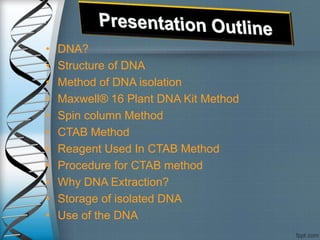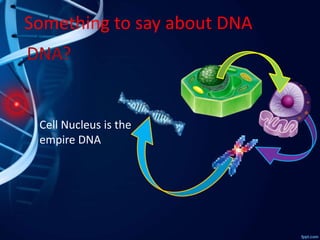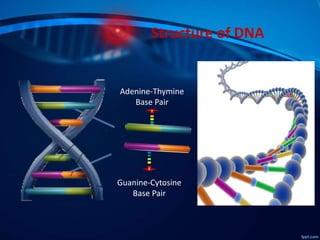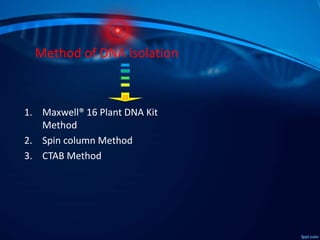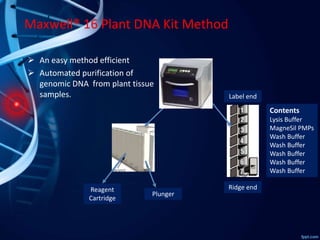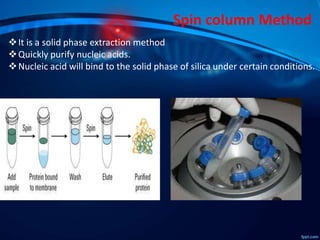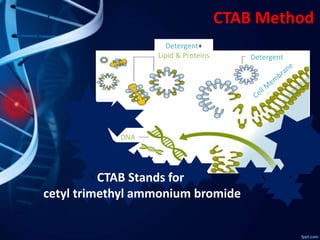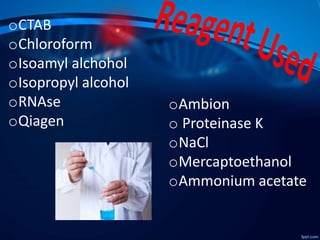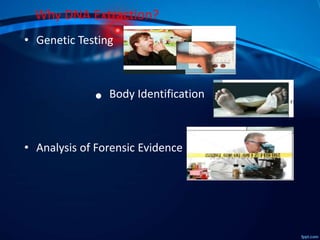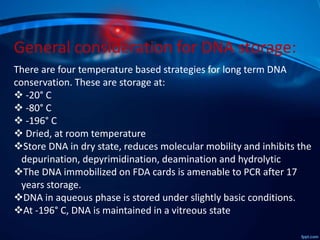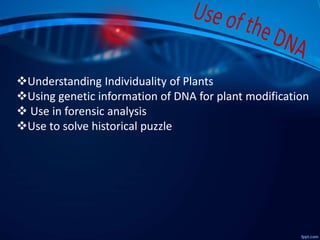Plant dna extraction method
- 4. âĒ DNA? âĒ Structure of DNA âĒ Method of DNA isolation âĒ MaxwellÂŪ 16 Plant DNA Kit Method âĒ Spin column Method âĒ CTAB Method âĒ Reagent Used In CTAB Method âĒ Procedure for CTAB method âĒ Why DNA Extraction? âĒ Storage of isolated DNA âĒ Use of the DNA
- 5. DNA? Something to say about DNA Cell Nucleus is the empire DNA
- 6. Structure of DNA Adenine-Thymine Base Pair Guanine-Cytosine Base Pair
- 7. 1. MaxwellÂŪ 16 Plant DNA Kit Method 2. Spin column Method 3. CTAB Method Method of DNA isolation
- 8. Ridge end Label end Contents Lysis Buffer MagneSil PMPs Wash Buffer Wash Buffer Wash Buffer Wash Buffer Wash Buffer Plunger Reagent Cartridge MaxwellÂŪ 16 Plant DNA Kit Method ï An easy method efficient ï Automated purification of genomic DNA from plant tissue samples.
- 9. Spin column Method ïķIt is a solid phase extraction method ïķQuickly purify nucleic acids. ïķNucleic acid will bind to the solid phase of silica under certain conditions.
- 10. CTAB Method Detergent+ Lipid & Proteins Detergent DNA CTAB Stands for cetyl trimethyl ammonium bromide
- 11. oCTAB oChloroform oIsoamyl alchohol oIsopropyl alcohol oRNAse oQiagen oAmbion o Proteinase K oNaCl oMercaptoethanol oAmmonium acetate
- 12. Procedure for CTAB method Sample extract CATB Centrifuge Carbohydrates, proteins, etc. Nucleic acid- CTAB complex DNA Precipitated Nucleic acid-CTAB complex
- 13. Why DNA Extraction? âĒ Genetic Testing Body Identification âĒ Analysis of Forensic Evidence
- 14. There are four temperature based strategies for long term DNA conservation. These are storage at: ïķ -20° C ïķ -80° C ïķ -196° C ïķ Dried, at room temperature ïķStore DNA in dry state, reduces molecular mobility and inhibits the depurination, depyrimidination, deamination and hydrolytic ïķThe DNA immobilized on FDA cards is amenable to PCR after 17 years storage. ïķDNA in aqueous phase is stored under slightly basic conditions. ïķAt -196° C, DNA is maintained in a vitreous state General consideration for DNA storage:
- 15. ïķUnderstanding Individuality of Plants ïķUsing genetic information of DNA for plant modification ïķ Use in forensic analysis ïķUse to solve historical puzzle



